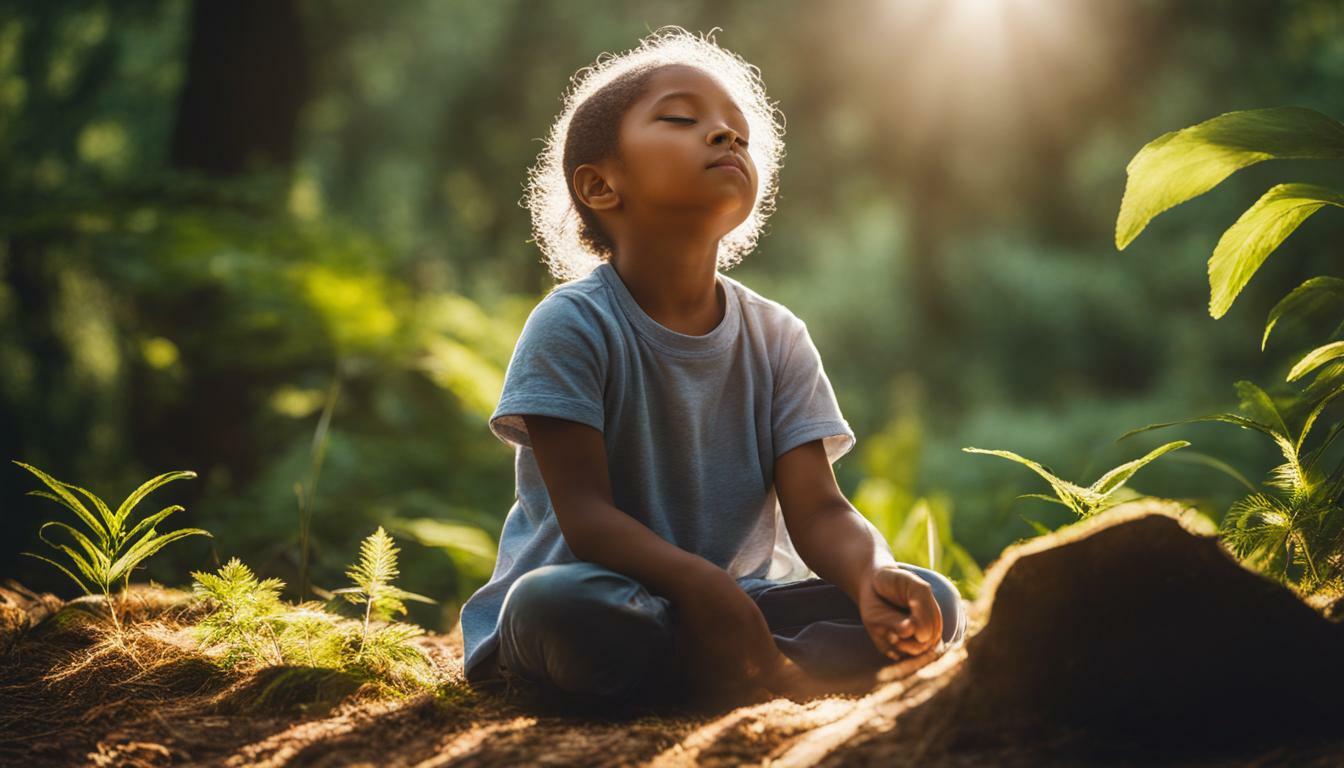Explaining meditation to a child can be done in a simple and engaging way. It is important to keep it simple and focused on the present moment. Meditation can be explained as noticing what is happening right now in the body, head, and surroundings. Using imagination and storytelling can make meditation more relatable for children. For example, they can imagine being in a beautiful place or compare their minds to a calm snow globe. It is also important to show children how to meditate by practicing together and using guided meditations designed for kids. Starting with short sessions and gradually increasing the duration can help children develop a regular meditation practice. Meditation for kids has numerous benefits, including improved sleep, increased focus, reduced stress and anxiety, and increased self-awareness and empathy. It is never too early to introduce meditation to children, and with patience and creativity, they can embrace it and reap the benefits throughout their lives.
Key Takeaways:
- Explaining meditation to children can be done in a simple and engaging way.
- Use imagination and storytelling to make meditation relatable for kids.
- Show children how to meditate by practicing together and using guided meditations.
- Start with short sessions and gradually increase the duration to develop a regular meditation practice.
- Meditation for kids has numerous benefits, including improved sleep, increased focus, reduced stress and anxiety, and increased self-awareness and empathy.
Benefits of Meditation for Children
Meditation for kids has numerous benefits that can positively impact their overall well-being. It is a powerful tool that can help children develop important skills such as improved sleep, increased focus, reduced stress and anxiety, and increased self-awareness and empathy.
One of the key benefits of meditation for children is improved sleep. Many children struggle with sleep issues, ranging from difficulty falling asleep to frequent waking during the night. Establishing a meditation practice before bed can help calm their minds and bodies, making it easier for children to relax and achieve a restful sleep.
In addition to better sleep, meditation also helps children increase their focus and concentration. With the distractions of technology and the demands of school, children often find it challenging to stay focused on tasks. Regular meditation practice enables children to train their minds to be present and concentrate on the task at hand, leading to improved academic performance and better overall focus.
Meditation is also an effective tool for reducing stress and anxiety in children. With the pressures of school, extracurricular activities, and social interactions, children can experience high levels of stress and anxiety. Mindfulness activities, such as deep breathing and guided meditations, can help children relax and manage their stress levels, promoting emotional well-being.
| Benefits of Meditation for Children |
|---|
| Improved sleep |
| Increased focus and concentration |
| Reduced stress and anxiety |
| Increased self-awareness and empathy |
Beyond these immediate benefits, meditation also cultivates important qualities like self-awareness and empathy. By teaching children to connect with their own thoughts and emotions, meditation helps them develop a deeper understanding of themselves. This self-awareness then extends to others, fostering empathy and compassion. These qualities are essential for healthy relationships and building a strong sense of community.
In summary, introducing meditation to children can have a profound impact on their well-being. By improving sleep, increasing focus, reducing stress, and fostering self-awareness and empathy, meditation equips children with valuable skills to navigate life’s challenges with resilience and serenity.
Techniques to Introduce Meditation to Kids
There are several techniques and activities that can help introduce meditation to children in a fun and engaging way. By keeping it simple and relatable, children can learn to embrace meditation and experience its many benefits. One effective technique is to use imagination and storytelling. Encourage your child to imagine themselves in a beautiful place, like a peaceful beach or a serene forest. Guide them to notice the sounds, smells, and sensations in their imagination, allowing them to fully engage with the present moment. This helps children understand that meditation is about being aware of what’s happening right now in their body, head, and surroundings. Another technique to introduce meditation to kids is to compare their minds to a calm snow globe. Explain to them that just like the snowflakes settling down in the globe, their thoughts can settle down too, creating a sense of peace and clarity. Encourage them to close their eyes and imagine their mind as a snow globe, gently shaking off any thoughts or worries, and allowing them to settle into a calm state. This visualization technique can make meditation more relatable for children and help them understand the concept of finding stillness within. Practicing guided meditations designed specifically for kids is also an effective way to introduce meditation. These guided meditations often incorporate storytelling and visualization, making it easier for children to follow along and stay engaged. You can find various guided meditation resources online or use meditation apps that offer kid-friendly content. By practicing together and using these guided meditations, you can show your child how to meditate and create a shared experience that strengthens your bond. Remember to start with short meditation sessions and gradually increase the duration as your child becomes more comfortable. Starting with just a few minutes a day can help them develop a regular meditation practice without feeling overwhelmed. And don’t forget to make it fun! Incorporate props or toys into the meditation practice, turning it into a game or an adventure. This will keep your child engaged and excited about meditation. Introducing meditation to children early on can have a profound impact on their overall well-being. It can help improve their sleep, increase their focus, reduce stress and anxiety, and foster self-awareness and empathy. With patience, creativity, and the right techniques, you can teach your child the valuable skill of meditation and set them on a path to a more mindful and balanced life.| Techniques to Introduce Meditation to Kids |
|---|
| Use imagination and storytelling |
| Compare minds to a calm snow globe |
| Practice guided meditations designed for kids |
| Start with short sessions and gradually increase duration |
| Make it fun by incorporating props or toys |
Teaching Meditation Through Practice
The best way to teach meditation to children is by practicing together and using language that they can easily understand. When introducing meditation to kids, it’s important to keep it simple and engaging. Start by explaining meditation as noticing what is happening right now in the body, head, and surroundings. You can encourage them to use their imagination and storytelling skills to make meditation more relatable and fun.
For example, ask them to imagine being in a beautiful place, such as a peaceful beach or a magical forest. Guide them to notice the sounds, smells, and sensations they would experience in that place. Another approach is to compare their minds to a calm snow globe. Explain that just like the snowflakes settling at the bottom of the globe, their thoughts and worries can also settle when they practice meditation.
Practicing together as a family can create a supportive and nurturing environment for children to explore meditation. Use guided meditations designed specifically for kids to help them understand the concepts and techniques. Start with short sessions, such as five minutes, and gradually increase the duration as they become more comfortable. This gradual approach helps children establish a regular meditation practice and build their attention span over time.
Table: Guided Meditation Activities for Kids
| Activity | Description |
|---|---|
| Imagination Journey | Guide your child on an imaginary journey to a peaceful place where they can visualize and experience relaxation. |
| Sensory Exploration | Engage their senses by asking them to notice the different sensations in their body, such as the feeling of their breath or the sensation of their feet on the ground. |
| Body Scan | Guide them to focus their attention on different parts of their body, starting from their toes and slowly moving up to their head. This helps them become more aware and present in their bodies. |
| Gratitude Meditation | Encourage them to reflect on things they are grateful for, helping them develop a positive mindset and appreciation for the present moment. |
Introducing meditation to children at an early age can have long-lasting benefits. Regular meditation practice can improve sleep, enhance focus and concentration, reduce stress and anxiety, and promote self-awareness and empathy. By teaching children how to cultivate a peaceful and calm state of mind, you are equipping them with valuable tools for navigating life’s challenges and fostering their overall well-being.
Starting Early: Introducing Relaxation Techniques to Children
It is never too early to introduce meditation and relaxation techniques to children, as these practices can have lifelong benefits. Teaching children how to relax and find inner peace can help them navigate the stresses of daily life and promote their overall well-being.
One effective way to introduce relaxation techniques to children is through guided meditations. Guided meditations provide children with a structured and engaging experience that can help them focus their minds and calm their bodies. You can find a variety of guided meditations designed specifically for kids, which incorporate playful elements like visualizations and storytelling.
In addition to guided meditations, incorporating simple breathing exercises can also help children relax. Teaching them to take deep breaths in and out, emphasizing the importance of slow and steady breathing, can help them regulate their emotions and find a sense of calm. You can make it more fun by encouraging them to imagine blowing out candles or pretending to be a flower blooming and closing.
| Benefits of Introducing Relaxation Techniques to Children |
|---|
| 1. Improved sleep: Many children struggle with sleep issues, such as difficulty falling asleep or staying asleep. Relaxation techniques can help calm their minds and bodies, promoting a more peaceful and restful sleep. |
| 2. Reduced stress and anxiety: Children experience stress and anxiety just like adults do. Teaching them relaxation techniques can provide them with tools to manage and reduce their stress levels, promoting a sense of calm and well-being. |
| 3. Increased self-awareness: Relaxation techniques can help children become more in tune with their emotions and physical sensations. By learning how to relax, they can better understand their own needs and feelings, fostering self-awareness and emotional intelligence. |
| 4. Enhanced focus and concentration: Relaxation techniques encourage children to practice mindfulness and stay present in the moment. This practice can improve their ability to focus and concentrate, which can benefit their academic performance and daily activities. |
Introducing relaxation techniques to children is a gift that can empower them with valuable coping skills and promote their overall well-being. By starting early and using creative and engaging approaches, you can help your child develop a lifelong practice of relaxation and mindfulness.
Making Meditation Fun and Engaging
Making meditation fun and engaging for children can help them develop a positive association with the practice. By incorporating creative techniques and interactive elements, children are more likely to enjoy and embrace meditation as a regular part of their lives.
One way to make meditation fun is by using visualizations. Encourage children to imagine themselves in a peaceful and beautiful place, like a magical forest or a sunny beach. By engaging their imagination, they can create a vivid mental image that helps them relax and focus.
Another technique is to incorporate props or toys into the meditation practice. For example, children can hold a small smooth stone in their hands and imagine it absorbing any worries or stress. This tangible object can provide a sensory experience and serve as a powerful tool for relaxation.
Turning meditation into a game is another effective method. You can create a mindfulness scavenger hunt where children search for items in their environment that represent different sensory experiences, such as something soft, something fragrant, or something that makes a soothing sound. This game not only keeps children engaged but also helps them cultivate mindfulness and awareness of their surroundings.
Remember to keep the meditation sessions short and age-appropriate for children. Starting with just a few minutes and gradually increasing the duration as they become more comfortable can help them build a regular meditation practice. Utilize guided meditations specifically designed for kids, which often incorporate playful language and interactive cues to make them more relatable and enjoyable.
| Benefits | Techniques |
|---|---|
|
|
Conclusion
Introducing meditation to children in a simple and engaging way can have numerous benefits for their overall well-being and development. Explaining meditation to a child can be done by keeping it simple and focused on the present moment. You can explain meditation as noticing what is happening right now in their body, head, and surroundings. Using imagination and storytelling can make meditation more relatable for children. For example, they can imagine being in a beautiful place or compare their minds to a calm snow globe.
Showcasing how to meditate by practicing together and using guided meditations designed specifically for kids is important. By starting with short meditation sessions and gradually increasing the duration, children can develop a regular meditation practice. The benefits of meditation for kids are numerous, including improved sleep, increased focus, reduced stress and anxiety, and increased self-awareness and empathy. It’s never too early to introduce meditation to children, and with patience and creativity, they can embrace it and reap the benefits throughout their lives.
Can the Breath Meditation Technique Be Explained to Children?
When it comes to teaching children about meditation, explaining breathing techniques for meditation is not only possible but also beneficial. By introducing simple concepts like taking deep breaths and focusing on the present moment, children can learn to regulate their emotions, reduce stress, and improve concentration. This approach allows young minds to cultivate mindfulness, fostering their well-being and emotional resilience.
FAQ
Q: How do I explain meditation to a child?
A: You can explain meditation to a child by telling them it’s about noticing what is happening right now in their body, head, and surroundings. You can also use imagination and storytelling to make it more relatable.
Q: What are the benefits of meditation for children?
A: Meditation has numerous benefits for children, including improved sleep, increased focus, reduced stress and anxiety, and increased self-awareness and empathy.
Q: How can I introduce meditation to kids?
A: There are various techniques to introduce meditation to kids, such as using imagination and storytelling, comparing their minds to a calm snow globe, and practicing guided meditations designed for kids.
Q: How do I teach meditation to children through practice?
A: It’s important to show children how to meditate by practicing together and using simple language to explain meditation. Start with short sessions and gradually increase the duration.
Q: Is it beneficial to introduce relaxation techniques to children at an early age?
A: Yes, starting early with meditation and relaxation techniques can have long-lasting benefits for children’s overall well-being.
Q: How can I make meditation fun and engaging for children?
A: You can make meditation fun and engaging for children by incorporating visualizations, using props or toys, and turning it into a game.








